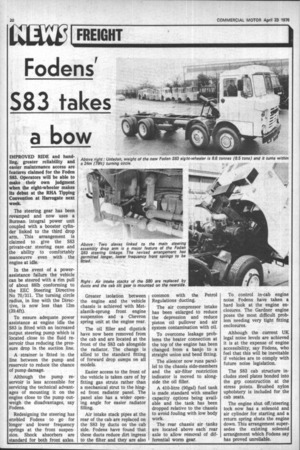Fodens ,
Page 22

If you've noticed an error in this article please click here to report it so we can fix it.
583 takes a bow
IMPROVED RIDE and handling, greater reliability and easier maintenance access are features claimed for the Foden S8.3. Operators will be able to make their own judgment when the eight-wheeler makes Its debut at the RHA Tipping Convention at Harrogate next week.
The steering gear has been revamped and now uses a Burman integral power unit coupled with a booster cylinder linked to the third drop arm. This arrangement is claimed to give the S83 private-car steering ease and the ability to comfortably manoeuvre even with the engine at idle.
In the event of a powerassistance failure the vehicle can be steered with a rim pull of about 881b conforming to the EEC Steering Directive No 70/311. The turning circle radius, in line with the Directive, is now less than 12m (39.4ft).
To ensure adequate power assistance at engine idle the S83 is fitted with an increased output steering pump which is located close to the fluid reservoir thus reducing the pressure drop in the suction line.
A strainer is fitted in the line between the pump and reservoir to reduce the chance of pump damage.
Although the pump reservoir is less accessible for servicing the technical advantages of mounting it on the engine close to the pump outweigh the disadvantages, say Fodens.
Redesigning the steering has enabled Fodens to go for longer and lower frequency springs at the front suspension. Shock absorbers are standard for both front axles. Greater isolation between the engine and the vehicle chassis is achieved with Metalastik-sprung front engine suspension and a Chevron spring unit at the engine rear.
The oil filler and dipstick have now been removed from the cab and are located at the front of the S83 cab alongside the radiator. The change is allied to the standard fitting of forward drop sumps on all models.
Easier access to the front of the vehicle is taken care of by fitting gas struts rather than a mechanical strut to the hinged front radiator panel. The panel also has a wider opening angle for easier radiator filling.
Air intake stack pipes at the rear of the cab are replaced on the S83 by ducts on the cab side. Fodens have found that these ducts reduce dirt ingress to the filter and they are also common with the Petrol Regulations ducting.
The air compressor intake has been enlarged to reduce the depression and reduce piston oil pullover and air system contamination with oil.
To overcome leakage problems the heater connection at the top of the engine has been changed from a banjo to a straight union and bend fitting.
The silencer now runs parallel to the chassis side-members and the air-filter restriction indicator is moved to alongside the oil filler.
A 410-litre (90gal) fuel tank is made standard with smaller capacity options being available and the tank has been dropped relative to the chassis to avoid fouling with low body work.
The rear chassis air tanks are located above each rear axle to allow removal of differential worm gear. To control in-cab engine noise Fodens have taken a hard look at the engine enclosures. The Gardner engine poses the most difficult problem needing very tight fitting enclosures.
Although the current UK legal noise levels are achieved it is at the expense of engine accessibility, say Fodens, who feel that this will be inevitable if vehicles are to comply with future noise legislation.
The S83 cab structure includes steel plates bonded into the grp construction at the stress points. Brushed nylon upholstery is included for the cab seats.
The engine shut off/steering lock now has a solenoid and air cylinder for starting and a return spring shuts the engine down. This arrangement supersedes the existing solenoid arrangement which Fodens say has proved unreliable.
































































































